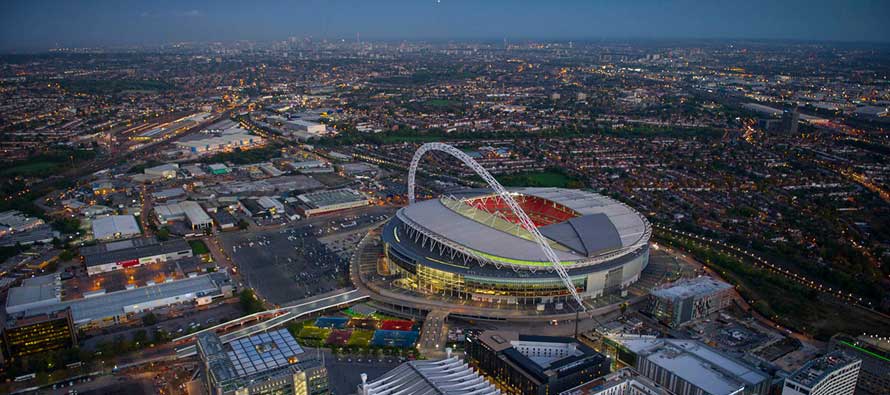Euro 2020 was originally due to be held between 12th June to 12th July in the Summer of 2020, but the tournament was postponed by 1 year due to the outbreak of the global COVID-19 pandemic.
Set to be the 16th itineration the tournament or the 60th birthday of the competition, Euro 2020 is set to be a unique spectacle as it will be held across 12 cities in 12 UEFA countries compared to the traditional format which sees either a single or a pair of countries hosting the entire tournament.
Described as a “romantic” one off format to celebrate the competition’s history, this article takes a quick look at the chosen host cities, and the stadiums involved. If you want to learn more about the tournament, check our our Euro 2020 stadium guide here or check out this link to view Euro 2021 odds.
Copenhagen, Denmark
The smallest stadium with a capacity of 38,065, Parken Stadium is home to FC Copenhagen and the Danish National Team. It’s notable for it’s retractable roof and a three star Michelin star restaurant within the eight floor of the stadium!
Dublin, Ireland
Aviva Stadium opened in 2010 and is built on the location of the former Lansdowne Road Stadium. Famed for it’s sleek iconic design, Ireland’s national stadium is jointly owned by the Irish Rugby Football Union and the Football Association of Ireland through a 50:50 venture.
Glasgow, Scotland
One of, if not the oldest stadiums to host matches in Euro 2020, Glasgow’s Hampden Park first opened in 1903. Despite Ibrox and Celtic Park offering more modern facilities, Hampden has continued to be the home of Scottish Football, although it is also used by Queen’s Park FC who often feature in League Two of Scottish football.
Bilbao, Spain
Home to Athletico Bilbao who are famously based in the Basque Country of Spain, San Mamés stadium dates back to 1913 when the first version of the stadium was built. Demolished, and completely rebuilt on the same site between 2010 and 2013, the stadium is often referred to as Nuevo San Mamés
Amsterdam, Netherlands
Known as the Amsterdam ArenA for many years, the largest stadium in Netherlands was renamed to the Johan Cruyff Arena in 2018 who sadly passed away 3 years earlier. The legendary footballer was an iconic of Dutch football and it was only fitting that he was honoured with such a gesture.
Bucharest, Romania
The new national stadium of Romania, the site on which the stadium sits previously belonged to the old Stadionul National which first opened in 1953. A designated UEFA Category Four stadium, the Arena Nationala has already used the UEFA Europa League finalin 2012, and continues to enjoy a growing reputation.
Budapest, Hungary
The newest stadium from all of the host countries, the new Puskas Arena is arguably the most exciting ground to host matches of Euro 2020. Built on the location of the outdated ground, the new arena was awarded 4 star status by UEFA and is a completely modern sporting arena.
Saint Petersburg, Russia
The new home of Zenit Saint Petersburg, the Krestovsky Stadium is perhaps better known as the Gazprom Arena after the Russian energy company who currently sponsor various parts of the UEFA Champions League. Liked to a space ship, the stadium opened in 2017 in time for the Confederations cup which acts as a curtain raiser to the 2018 World Cup the following year.
Baku, Azerbaijan
Very much an outside choice for European Stadiums and indeed venues, The Baku Olympic Stadium is a modern ground which replaced the outdated Tofiq Bahramov Republic Stadium as the national stadium of Azerbaijan. Known for hosting the Europa Final in 2019, it was a controversial decision due to the absence of Henrikh Mkhitaryan who was absent due to an ongoing conflict with Armenia.
Rome, Italy
Regarded as one of the iconic footballing venues in World Football after hosting the legendary Italia 90 World Cup, and known as the home of Roma and Lazio – the inclusion of Rome’s Stadio Olimpico was pretty much a given. The second largest stadium in Italy after the San Siro, it’s known for hosting a variety of sports and was significantly renovated between 2007 and 2008.
Munich, Germany
The penultimate stadium on this list, the Allianz Arena is home to Bayern Munich who are one of the powerhouses of European Football. Opened in 2005, in time for the World Cup the following year, the design is famous for it’s use of inflated plastic panels with a fully colour changing exterior. For UEFA Competitions the stadium is usually known as Football Arena Munchen.
London, England
Last but not least we have England’s Wembley Stadium which some regard as “the home of football”, not just domestically but around the world. Located on the site of the original Wembley, the ground opened with a capacity of 90,000 and is set to host the semi-finals and finals of this illustrious competition, having also done so previously in 1996.

